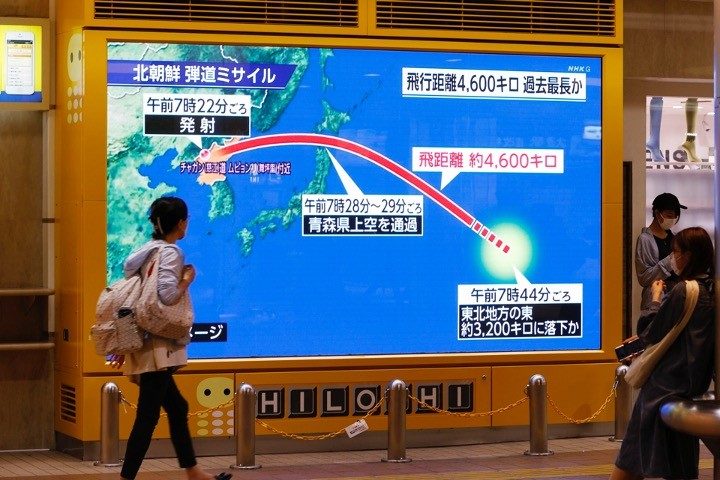
SINGAPORE — On Oct. 4, North Korea launched a ballistic missile over Japan for the first time in five years, leading Tokyo to turn on its missile alert system and caution people to take shelter.
Tuesday’s launch, which the United States decried as “reckless and dangerous,” comes amid a series of provocative weapons-tests by North Korea this year. Recently, the hermit kingdom amended its laws to position itself an “irreversible” nuclear power.
Japanese Prime Minister Fumio Kishida called the launch “an act of violence,” and European Union head Charles Michel condemned it as “an unjustified aggression.”
The U.S. State Department denounced the act, calling it a “reckless and dangerous launch” that was “an unacceptable threat to the Japanese public.” President Joe Biden reiterated Washington’s “ironclad commitment” to Japan’s defense during a phone call with Kishida, as the two leaders jointly castigated the missile test, a White House statement said.
South Korean President Yoon Suk-yeol lambasted the firing as a “provocation” that breached UN regulations, and pledged a “stern response.” Moreover, South Korea claimed the intermediate-range ballistic missile (IRBM) flew some 4,500 kilometers (2,800 miles), potentially a new distance record for North Korean tests.
North Korea failed to respond to regular daily contact on the inter-Korean liaison line Tuesday, based on reports by South Korea’s unification ministry.
The last time North Korea fired a missile over Japan was in 2017, at the pinnacle of hostilities of “fire and fury” when Pyongyang’s leader Kim Jong Un exchanged barbs with U.S. president Donald Trump. Pyongyang has tested nuclear weapons six times since 2006.
South Korean and U.S. officials have been cautioning for months that North Korea’s Kim is preparing to launch another nuclear test, saying last week that this could occur soon after the Chinese Communist Party’s Congress, which begins October 16. However, some observers believe Tuesday’s launch proves that North Korea is arranging for a nuclear test sooner than expected.
Tuesday’s test is Pyongyang’s fifth missile launch in 10 days and signals a clear message to the United States, Park Won-gon, professor of North Korean Studies at Ewha University, told AFP.
The missiles “put South Korea, Japan, and Guam within range,” and prove that Pyongyang could strike U.S. bases with nukes if war broke out on the Korean peninsula, Park warned. “As these are missiles that can carry nuclear warheads, the launch also has a political goal of once again declaring North Korea a de facto nuclear power and showing its complete denuclearisation is impossible.”
Seoul, Tokyo, and Washington have been increasing their joint military drills to tackle Pyongyang’s growing aggression, conducting the first trilateral anti-submarine drills in five years last Friday. Just a few days earlier, the U.S. and South Korean navies had organized large-scale exercises.
Such drills infuriate North Korea, which sees them as rehearsals for an invasion.
Furthermore, U.S. Vice President Kamala Harris visited Seoul and the heavily guarded Demilitarized Zone (DMZ) that separates the two Koreas last week. Harris’ trip was meant to showcase the United States’ “ironclad” commitment to South Korea’s defense.
Japanese Defense Minister Yasukazu Hamada estimated that the missile could have been a Hwasong-12, and added that Japan would not rule out any options to bolster its defenses, including “counterattack capabilities.” He and Prime Minister Kishida confirmed they would collaborate with South Korea and the international community to stage an immediate and longer-term response to the threat from the north.
Notably, neither North Korea’s government nor its state media have mentioned Tuesday’s launch or divulged what type of missile was used.
The missile launch over Japan signified a “significant escalation” by North Korea, claimed Leif-Eric Easley, a professor at Ewha University in Seoul. “Pyongyang is still in the middle of a provocation and testing cycle.”
“North Korea always starts with a low-level provocation and gradually raises the level to attract media attention from all over the world,” said Go Myong-hyun, a researcher at the Asan Institute for Policy Studies.
“Their final provocation will probably be a nuclear test,” he said, highlighting that North Korea chose the “very aggressive” step of overflying Japan to attract more attention. “By launching the missile over Japan, they are showing that their nuclear threat is not just targeting South Korea.”
Based on reports, people in the north of Japan, including Hokkaido island and Aomori city, were awakened by sirens and text alerts reading “North Korea appears to have launched a missile. Please evacuate into buildings or underground.” Residents were also directed to watch out for falling debris as the missile flew overhead.
A Twitter video depicting Tokyo commuters walking normally as loudspeakers blared out warnings showed that many remained calm despite the perceived missile threat, although others were more traumatized. “If a missile hit, I was worried it would be a big problem not only here but also nationwide,” Aomori resident Kazuko Ebina revealed to Japan’s Asahi Shimbun newspaper.
Officials later confirmed the intermediate-range ballistic missile fell into the Pacific Ocean far from Japan, and there were no reported injuries. The missile had covered the longest distance ever traveled by a North Korean missile, and achieved a height of around 1,000km — higher than the International Space Station.
Firing over or past Japan permits North Korean scientists to trial missiles under conditions “that are more representative of the conditions they’d endure in real-world use,” analyst Ankit Panda revealed to news agency Reuters.
These bellicose actions have added to existing animosities between North Korea and Japan that originated in Japan’s occupation of Korea from 1910 to 1945 and North Korea’s subsequent kidnapping of Japanese citizens.
In retaliation for the missile launch by the North, South Korea and the U.S. military conducted missile drills. Both South Korean and American troops fired a volley of missiles into the sea, said South Korea’s Joint Chiefs of Staff on Wednesday. The allies had previously conducted a bombing drill with fighter jets in the Yellow Sea. The military also confirmed that a South Korean Hyunmoo-2 missile failed briefly after launch and crashed during the drill, but added that no one was hurt.
The United States petitioned for the globalist 15-member UN Security Council to convene on Wednesday. “We must limit the DPRK’s ability to advance its unlawful ballistic missile and weapons of mass destruction programs,” tweeted U.S. Ambassador to the United Nations Linda Thomas-Greenfield after urging for the meeting. The U.S. request was backed by Britain, France, Albania, Norway, and Ireland, but China and Russia disagreed to a public discussion by the council.




